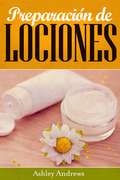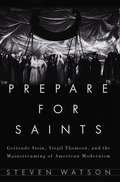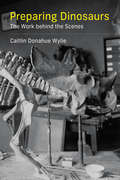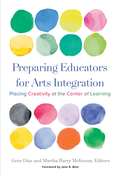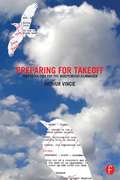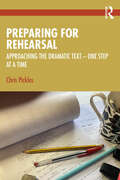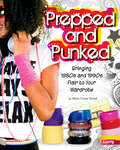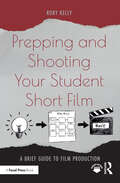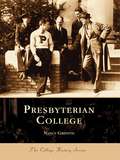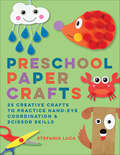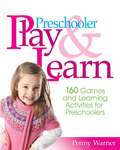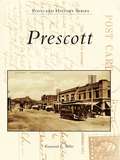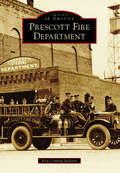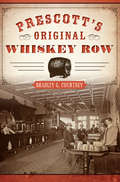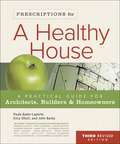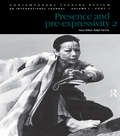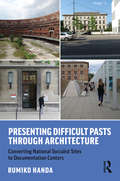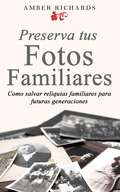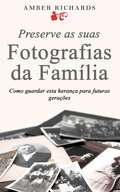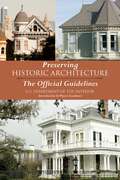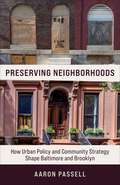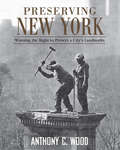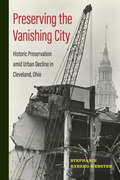- Table View
- List View
Preparación de Lociones: Una Guía HTM (Hazlo Tú Mismo) para Preparar Lociones Desde lo Básico
by Ashley Andrews David Arieta GalvánAltamente subestimada, la loción es el héroe anónimo de nuestras bolsas de mano, lavabos y botiquines, con usos esenciales desde protección solar hasta prevención antienvejecimiento. Estas útiles cremas son absolutamente indispensables cuando se trata de mantener la piel saludable y vibrante. Por qué preparar lociones debe ser una parte fundamental de tu día... Piel seca y quebradiza debido al amargo invierno. Quemaduras de sol debido a los veranos más calientes. Nuestra piel necesita más atención de la que a veces le damos. Incluso si tu piel tiende a ser grasosa, es importante utilizar regularmente una loción hidratante para mantener un cuerpo saludable y prevenir el rápido e innecesario envejecimiento de tu piel. La loción es tan importante para la piel como el agua para tu cuerpo. Repara, protege, mejora la circulación sanguínea y sirve como un valioso tapa-poros para el maquillaje. ¿Pero por qué apegarse a las marcas convencionales? ¿Por qué no preparar tus propias lociones personalizadas con tus esencias e ingredientes favoritos? Aprende Como Preparar Fáciles Cremas Corporales y Lociones en Casa Repleto de recetas, este libro te guiará a través de un montón de maravillosas creaciones artesanales que son fáciles, divertidas y con una gran base para un principiante. Disfrutarás preparar las siguientes recetas: Loción Fundamental Totalmente Natural para Principiantes Loción Brillante de Champaña Crema Corporal de Café Crema Corporal Batida de Calabaza y Especia Loción Bronceadora Loción con Brillo Loción de Galleta de Azúcar Y más... Esta guía para preparar lociones HTM (Hazlo Tú Mismo) te dará para crear tus propios brebajes desde lo básico en un santiamén. Estarás repartiendo regalos para navidad y cumpleaños y no hay duda de que te pedirán más. Es verdad, Preparación de Lociones: Una Guía
Prepare for Saints: Gertrude Stein, Virgil Thomson, and the Mainstreaming of American Modernism
by Steven WatsonPerhaps the oddest and most influential collaboration in the history of American modernism was hatched in 1926, when a young Virgil Thomson knocked on Gertrude Stein's door in Paris. Eight years later, their opera Four Saints in Three Acts became a sensation--the longest-running opera in Broadway history to date and the most widely reported cultural event of its time. Four Saints was proclaimed the birth of a new art form, a cellophane fantasy, "cubism on stage." It swept the public imagination, inspiring new art and new language, and defied every convention of what an opera should be. Everything about it was revolution-ary: Stein's abstract text and Thomson's homespun music, the all-black cast, the costumes, and the com-bustible sets. Moving from the Wadsworth Atheneum to Broadway, Four Saints was the first popular modernist production. It brought modernism, with all its flamboyant outrage against convention, into the mainstream. This is the story of how that opera came to be. It involves artists, writers, musicians, salon hostesses, and an underwear manufacturer with an appetite for publicity. The opera's success depended on a handful of Harvard-trained men who shaped America's first museums of modern art. The elaborately intertwined lives of the collaborators provide a window onto the pioneering generation that defined modern taste in America in the 1920s and 1930s. A brilliant cultural historian with a talent for bringing the past to life, Steven Watson spent ten years researching and writing this book, interviewing many of the collaborators and performers. Prepare for Saints is the first book to describe this pivotal moment in American cultural history. It does so with a spirit and irreverence worthy of its subject.NOTE: This edition does not include photographs.
Preparing Dinosaurs: The Work behind the Scenes
by Caitlin Donahue WylieAn investigation of the work and workers in fossil preparation labs reveals the often unacknowledged creativity and problem-solving on which scientists rely.Those awe-inspiring dinosaur skeletons on display in museums do not spring fully assembled from the earth. Technicians known as preparators have painstakingly removed the fossils from rock, repaired broken bones, and reconstructed missing pieces to create them. These specimens are foundational evidence for paleontologists, and yet the work and workers in fossil preparation labs go largely unacknowledged in publications and specimen records. In this book, Caitlin Wylie investigates the skilled labor of fossil preparators and argues for a new model of science that includes all research work and workers.Drawing on ethnographic observations and interviews, Wylie shows that the everyday work of fossil preparation requires creativity, problem-solving, and craft. She finds that preparators privilege their own skills over technology and that scientists prefer to rely on these trusted technicians rather than new technologies. Wylie examines how fossil preparators decide what fossils, and therefore dinosaurs, look like; how labor relations between interdependent yet hierarchically unequal collaborators influence scientific practice; how some museums display preparators at work behind glass, as if they were another exhibit; and how these workers learn their skills without formal training or scientific credentials. The work of preparing specimens is a crucial component of scientific research, although it leaves few written traces. Wylie argues that the paleontology research community's social structure demonstrates how other sciences might incorporate non-scientists into research work, empowering and educating both scientists and nonscientists.
Preparing Educators for Arts Integration: Placing Creativity at the Center of Learning
by Gene Diaz Martha McKennaThis resource examines professional development approaches from across the United States to help schools and allied arts groups integrate the arts into an already crowded K–12 curriculum. The authors document the purposes and structures of a broad spectrum of current efforts and programs. Several of these programs have been in place for decades, thus demonstrating their sustainability and effectiveness. Emphasizing the value of collaboration among teachers, artists, educational leaders, and community partners, the book draws on the broad range of experiences of the authors, who came together as a working group of the Arts Education Partnership. Readers will find strong, empirically tested models of arts integration to inform curriculum development and teacher professional learning.
Preparing For Takeoff: Preproduction for the Independent Filmmaker
by Arthur VincieYou have the camera, time, money (or credit card), so why don't you just start shooting? Preparing for Takeoff will give you the tools you need to fully prepare for your independent film. This book features: Vital preproduction tips on scheduling, previsualization, script analysis, location scouting, budgeting, hiring vendors, and clearing permits A detailed analysis of the role both producers and directors play in the preproduction process Crucial advice on how to prepare for postproduction and distribution while still in the early stages of making a film Lessons from the field in how to avoid mid-shoot changes, unhappy actors, fostering a resentful crew, wasted days and dwindling finances An accompanying website that includes sample script analyses, storyboards, beat sheets, editable budget forms, and more
Preparing for Rehearsal: Approaching the Dramatic Text – One Step at a Time
by Chris PicklesA resource for actors, directors, and writers (both professional and in training), this is a step-by-step, practical guidebook to the pre-rehearsal analysis of a script. Its aim is to de-mystify and organise the questions necessary to ask in order to prepare for a creative, imaginative and fruitful exploration of a dramatic text in the journey towards rehearsal.The language is unselfconsciously engaging and accessible, uncluttered by alienating academic vocabulary. It holds out a helping hand throughout the important and sometimes rather lonely time of preparation for rehearsal, a time of exploration usually spent without the reassuring guidance of a director or dramaturg. The volume takes the reader on a journey, chapter by chapter, from first reading of a script to arrival in the rehearsal room or film studio for the first readthrough or day of shooting. The book maps out six investigations for the actor or director, and most importantly, the order in which those explorations should be tackled. This book also forms the basis of any core text analysis module for students studying on professional acting, theatre arts, scriptwriting, media, and film or directing degrees at a university, college, or conservatoire level.A professional director, actor and writer, this guide is also a result of Chris Pickles’ many years of experience not only in running workshops for theatre professionals, but also teaching text analysis to actors and directors in training.
Prepped and Punked: Bringing 1980s And 1990s Flair To Your Wardrobe (Fashion Forward Ser.)
by Allison Crotzer KimmelPrepping and Shooting Your Student Short Film: A Brief Guide to Film Production
by Rory KellyFocusing on the practical tools required to making your first student film, this book is a concise and accessible guide to film production. Demystifying the process of taking a film from concept through to production, author Rory Kelly covers all the key bases including: organizing your script, when and how to shoot, production budgeting, finding actors and locations, and roadmapping postproduction. Featuring common problems and challenges producers and directors face throughout the production process and providing practical solutions, the book illustrates how to effectively create a film that can be successfully shot in a classroom or micro-budget environment. Filmmakers will be empowered to prioritize realistic goals, balance practical and creative demands, manage a budget, and schedule time to ensure concept translates to reality. Kelly brings together the creative process and practicalities of producing a student film. A concise and accessible guide written with the specific constraints of a student production in mind, this book will equip any filmmaker with the tools to produce an impactful short film. Ideal for undergraduate and graduate students of filmmaking, amateur filmmakers, as well as students in high school, community-based, for-profit and summer filmmaking programs. Additional downloadable online resources include a look-book with images and video clips, as well as printable budget templates, shooting schedule templates, block breakdown sheets, a digital workflow worksheet, timed shot-list forms and templates for location agreements, appearance releases, crew deal memos and call sheets.
Presbyterian College
by Nancy GriffithFounded in 1880, Presbyterian College exists today as the manifestation of one man's dream. William Plumer Jacobs, minister of Clinton's first Presbyterian church and founder of Thornwell Orphanage, envisioned Clinton as a center for Presbyterian education in South Carolina. His dream, supported by generations who followed him, has created and maintained this strong liberal arts college, keeping it rich in the ideals of honor and service.Presbyterian College includes more than 200 vintage photographs that trace the course of the college's development over its near 125-year existence. Dedicated presidents, inspiring faculty, and a variety of students are featured, as well as the campus's Georgian architecture, which immediately signifies Presbyterian College. The long and rich Blue Hose athletic tradition is thoroughly explored and varied aspects of student life-from choir tours to Greek life-are recounted.
Preschool Paper Crafts: 25 Creative Crafts to Practice Hand-Eye Coordination & Scissor Skills
by Stefania LucaKeep little hands busy with 25 fun and simple paper crafts for ages 3 to 5 Developing fine motor skills and hand-eye coordination is so important for preschoolers, and paper crafts are the perfect way for little hands to practice. This book comes with 25 adorable projects that include easy instructions and simple templates for kids to cut out. The best part? Each craft requires only a few materials that you probably already have at home.What sets this preschool crafts book apart from other scissor skills activity books:Help them build their skills—Toddlers can improve their dexterity, and become better coordinated, as they cut out a twirly snake, an interactive sailboat, royal hand puppets, and more.Bond as you craft together—Enjoy quality time with your little one and watch them learn as they create these cute projects with your help.Spark their creativity—Get kids excited about creating crafts using only scissors, a few simple supplies, and the one magical (and affordable!) material that always comes through for kids: paper.Focus on your child's fine motor development while making happy memories with this scissor skills preschool workbook for kids.
Preschooler Play & Learn: 160 Games and Learning Activities for Preschoolers
by Penny WarnerThe Most Complete Book of Games and Learning Activities for Preschoolers! Child development expert Penny Warner offers 150 illustrated ideas for games and activities designed to stimulate your preschooler's learning and development. For each game and activity, Preschooler Play & Learn includes: recommended ages, a detailed list of easy-to-find materials, a bulleted list of the skills that preschoolers will learn, step-by-step instruction, clear illustrations, variations for added fun and enhanced learning, and safety tips and other helpful hints. Preschooler Play & Learn is designed to help children reach their full potential and have a good time along the way.
Prescott
by Raymond E. MillerPrescott was founded in 1864 as the territorial capital of Arizona. In 1900, the business center burned to the ground, but the courthouse in the town square was saved, and the burned-out area's former wooden buildings were replaced by brick structures. Because the closest interstate highway is more than 30 miles away, much of Prescott's history and sense of community have been preserved, and historical districts abound. The local chamber of commerce refers to Prescott as "Everybody's Hometown." It is also known as the "Christmas City of Arizona" and holds an annual Christmas parade, with appropriate courthouse lighting.
Prescott Fire Department (Images of America)
by Eric Conrad JacksonFounded in 1885, the Prescott Fire Department began with four 25-man volunteer companies, the Dudes, the Toughs, the Mechanics Hook & Ladders, and the O.K.s. These 100 men reflected both the common man and the leaders of the region. Over the years, their numbers would include governors-to-be F.A. Tritle and Thomas Campbell, business leaders H.D. Aitken and A.A. "Tony" Johns, and numerous members of the Goldwater family. The department and its community survived the great fire of July 14, 1900, as well as the loss of 19 of its own Granite Mountain Hotshots on June 30, 2013. The Prescott Fire Department would go from a volunteer department to a fully paid department of 80 firefighters, operating out of five stations and covering an area of 40 square miles.
Prescott’s Original Whiskey Row
by Bradley G. CourtneySome of the oldest, most notorious saloons in the American West lined the streets of Prescott's Whiskey Row. Dating back to 1864, the remote mountain town thrived on its mining and cattle industries during the day and raised hell at night when dusty outlaws and pioneers like Virgil Earp and Doc Holliday crowded Row saloons to quench their thirsts. Whiskey Row bore witness to legendary gunfights, murders and other curious tales, like that of Baby Bell, aka Chance Cobweb Hall, known today as Arizona's most famous saloon story. From crooked gambling operations and barroom brawls to the devastating fire of 1900, author and historian Bradley G. Courtney explores the colorful stories of Whiskey Row.
Prescriptions for a Healthy House: A Practical Guide for Architects, Builders & Homeowners
by Dr Erica Elliott John Banta Paula Baker-LaporteAlthough there is nothing complicated about constructing healthier homes, building for health is still not standard practice, and in fact there are many aspects of conventional home construction that are detrimental to human well-being.From foundation to rooftop, to home care and repair, Prescriptions for a Healthy House takes the mystery out of healthy-house building, renovation, and maintenance by walking the owner/architect/builder team through the entire construction process. Chapters include:Frame construction alternativesThermal and moisture controlFlooring and finishesFurnishingsThe authors--an architect, medical doctor, and restoration consultant--bring a singular combination of expertise and perspectives to this book. The result--now in its third completely updated edition--is a unique guide to creating healthy indoor and outdoor spaces, including many new resources, as well as specialized knowledge from several nationally recognized experts in the field of building biology.This unique guide will appeal to architects, designers, contractors, medical professionals, and homeowners.Paula Baker-Laporte is the principal architect and founder of Baker-Laporte & Associates and EcoNest Design. John Banta is a senior indoor environmental consultant for Restorations Consultants, Inc. Erica Elliott, MD is a medical doctor specializing in environmental medicine and family practice.
Presence and Pre-Expressivity 2
by Ralph YarrowThis is Volume 7, Part I of the Contemporary Theatre Review, an International Journal, with this edition focusing on Prescence and pre-expressivity. Covering topics such as Body in Mind: Exploring Pre-Expressivity; Peter Brook and Traditional Thought; Grotowski, Holiness, and the Pre-Expressive; Barba's Concepts of the Pre-Expressive and the Third Organ of the Body of the Theatre and Theories of Consciousness; Pre-Expressivity: Some Thoughts from the Rehearsal Floor.
Present Concerns: Journalistic Essays
by C. S. LewisA repackaged edition of the revered author’s essays in which he deliberates on contemporary issues, from the moral to the spiritual to the practical.C. S. Lewis—the great British writer, scholar, lay theologian, broadcaster, Christian apologist, and bestselling author of Mere Christianity, The Screwtape Letters, The Great Divorce, The Chronicles of Narnia, and many other beloved classics—was one of the foremost religious philosophers of the twentieth century; a thinker whose far-reaching influence on Christianity continues to be felt today.Demonstrating Lewis’s wide range of interests, Present Concerns includes nineteen essays that reveal his thoughts about democratic values, threats to educational and spiritual fulfillment, literary censorship, and other timely topics, offering invaluable wisdom for our own times.
Present Perfect: 25 Gifts to Sew & Bestow
by Betz WhiteBeautiful handmade gifts for all occasions! In Present Perfect, you'll discover gifts to sew for all of life's major celebrations: birthdays, graduations, anniversaries, new homes, new babies, or simply "just because." Betz White, known for her earth- and family-friendly designs, offers a new collection of sewing projects for you to stitch and give to those you love. Projects include cuddly toys for babies and toddlers, clever bags and accessories for women and men, and beautiful items for the modern home. Sewers with a range of abilities, from confident beginner to seasoned seamstress, will find the projects achievable and enjoyable to make. Each handmade gift begins with a thoughtful selection of materials just right for the project and the recipient. Throughout this book Betz also offers hints for using alternative materials and ideas for upcycling. Reusing a favorite fabric with a history, such as outgrown baby clothing, a grandfather's necktie, or a vintage tablecloth, can add meaning to a truly memorable gift.
Presenting Difficult Pasts Through Architecture: Converting National Socialist Sites to Documentation Centers
by Rumiko HandaArchitectural design can play a role in helping make the past present in meaningful ways when applied to preexisting buildings and places that carry notable and troubling pasts. In this comparative analysis, Rumiko Handa establishes the critical role architectural designs play in presenting difficult pasts by examining documentation centers on National Socialism in Germany. Presenting Difficult Pasts Through Architecture analyzes four centers – Cologne, Nuremberg, Berlin, and Munich – from the point of view of their shared intent to make the past present at National Socialists' perpetrator sites. Applying original frameworks, Handa considers what more architectural design could do toward meaningful representations and interpretations of difficult pasts. This book is a must-read for students, practitioners, and academics interested in how architectural design can participate in presenting the difficult pasts of historical places in meaningful ways.
Preserva tus fotos familiares: Como salvar reliquias familiares para futuras generaciones
by Amber Richards David Arieta Galván¿Valoras tus fotografías familiares? ¡Entonces esta es una guía obligada para ti! No te arriesgues a perder para siempre estos tesoros irremplazables! Nuestras fotos familiares son invaluables, un registro visual de memorias y personas queridas. Merecen y requieren especial cuidado para garantizar que aun estarán presentes para pasar a futuras generaciones. Quienes disfrutan de la genealogía familiar también tienen colecciones increíbles de fotos familiares antiguas que necesitan extra cuidado para preservarlas. Aprende como tomar los pasos prácticos para proteger tus fotos familiares, tanto físicas como en formato digital. Asegura que tus tesoros sobrevivan y no enfrentes la pérdida trágica de estas imágenes. Descarga tu copia ahora.
Preserve As Suas Fotografias Da Família - Como Guardar Esta Herança Para Futuras Gerações
by Elvira Sousa Amber RichardsVocê dá valor aos retratos e às fotografias da família? Então, este livro é um guia indispensável para si! Não arrisque perder esses tesouros insubstituíveis para sempre. As nossas fotografias da família não têm preço; elas são o registo visual das nossas memórias e das pessoas que amamos. Por isso, merecem e precisam de um carinho especial para garantirmos que cheguem às próximas gerações. Há muitas pessoas empenhadas na construção da árvore genealógica da família e, como tal, possuem inúmeras fotografias vintage que precisam de cuidados especiais para a sua preservação. Aprenda com estes conselhos práticos e proteja as suas fotografias da sua família, em suporte papel ou formato digital. Garanta a sobrevivência destes tesouros, evitando uma perda irreparável. Faça agora o seu download.
Preserving Historic Architecture: The Official Guidelines
by Wayne Goodman U.S. Department InteriorThe National Park Service, a branch of the Department of the Interior, knows preservation. In its hundred-year existence, the service has dealt with just about every problem an old structure can have. Whether it is removing graffiti in Manhattan or rebuilding a barn in Oregon, the National Park Service knows what to do. Here are the official U.S. guidelines, a lively and instructive collection of tried and tested knowledge and reliable techniques, written by the top experts in the field. Over forty fully illustrated chapters addressing topics such as: — cleaning and waterproof coating of historic masonry — roofing for historic buildings— the preservation of historic glazed architectural terra-cotta — exterior paint problems on historic woodwork — the preservation of historic barns — heating, ventilating, and cooling historic buildings — historic signs — applied decoration for historic interiors — using substitute materials on historic building exteriors — understanding old buildings — understanding architectural cast iron Every chapter is written with the utmost detail and clarity so that any reader can perform the safest and most historically accurate repairs. The book also offers invaluable advice on what not to do that can save a homeowner thousands of dollars, hours, and perhaps a priceless piece of architecture. For the hobbyist or the professional restorer, The Preservation of Historic Architecture is the definitive government text on restoring, repairing, and preserving old buildings.
Preserving Neighborhoods: How Urban Policy and Community Strategy Shape Baltimore and Brooklyn
by Aaron PassellHistoric preservation is typically regarded as an elitist practice. In this view, designating a neighborhood as historic is a project by and for affluent residents concerned with aesthetics, not affordability. It leads to gentrification and rising property values for wealthy homeowners, while displacement afflicts longer-term, lower-income residents of the neighborhood, often people of color.Through rich case studies of Baltimore and Brooklyn, Aaron Passell complicates this story, exploring how community activists and local governments use historic preservation to accelerate or slow down neighborhood change. He argues that this form of regulation is one of the few remaining urban policy interventions that enable communities to exercise some control over the changing built environments of their neighborhoods. In Baltimore, it is part of a primarily top-down strategy for channeling investment into historic neighborhoods, many of them plagued by vacancy and abandonment. In central Brooklyn, neighborhood groups have discovered the utility of landmark district designation as they seek to mitigate rapid change with whatever legal tools they can. The contrast between Baltimore and Brooklyn reveals that the relationship between historic preservation and neighborhood change varies not only from city to city, but even from neighborhood to neighborhood. In speaking with local activists, Passell finds that historic district designation and enforcement efforts can be a part of neighborhood community building and bottom-up revitalization.Featuring compelling narrative interviews alongside quantitative data, Preserving Neighborhoods is a nuanced mixed-methods study of an important local-level urban policy and its surprisingly varied consequences.
Preserving New York: Winning the Right to Protect a City’s Landmarks
by Anthony WoodPreserving New York is the largely unknown inspiring story of the origins of New York City’s nationally acclaimed landmarks law. The decades of struggle behind the law, its intellectual origins, the men and women who fought for it, the forces that shaped it, and the buildings lost and saved on the way to its ultimate passage, span from 1913 to 1965. Intended for the interested public as well as students of New York City history, architecture, and preservation itself, over 100 illustrations help reveal a history richer and more complex than the accepted myth that the landmarks law sprang from the wreckage of the great Pennsylvania Station. Images include those by noted historic photographers as well as those from newspaper accounts of the time. Forgotten civic leaders such as Albert S. Bard and lost buildings including the Brokaw Mansions, are unveiled in an extensively researched narrative bringing this essential episode in New York’s history to future generations tasked with protecting the city’s landmarks. For the first time, the story of how New York won the right to protect its treasured buildings, neighborhoods and special places is brought together to enjoy, inform, and inspire all who love New York.
Preserving the Vanishing City: Historic Preservation amid Urban Decline in Cleveland, Ohio (Urban Life, Landscape and Policy)
by Stephanie Ryberg-WebsterPreserving the Vanishing City considers the unique challenges, conditions, and opportunities facing Cleveland’s historic preservation community during the 1970s and 1980s. While pro-preservationists argued for the economic and revitalization benefits stemming from saving and repurposing older buildings, population loss and economic contraction prompted decades of deterioration, underinvestment, vacancy, and abandonment. Stephanie Ryberg-Webster uncovers the motivations, strategies, and constraints driving Cleveland’s historic preservation sector, led by the public-sector Cleveland Landmarks Commission, nonprofit Cleveland Restoration Society, and a cadre of advocates. She sheds light on the ways in which preservationists confronted severe, escalating, and sustained urban decline, which plagued Cleveland, a prototypical rust-belt industrial city. Preserving the Vanishing City chronicles the rise of the historic preservation profession in Cleveland and provides six case studies about targeted projects and neighborhood efforts, including industrial heritage, housing preservation and restoration, commercial district revitalization, securing local historic district designations, as well as grassroots organizing, coalition building, and partnerships. Ryberg-Webster also addresses the complexities of historic preservation within the context of rapid racial change in Cleveland’s neighborhoods. A comprehensive history of preservation within the context of one city’s urban decline, Preserving the Vanishing Cityrecounts the successes, failures, and creative strategies employed to save Cleveland’s built environment.
